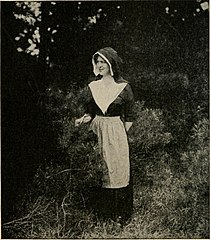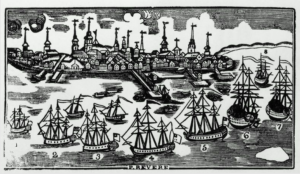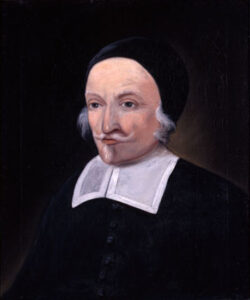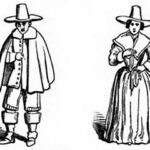
While the manuscript for Sea Tigers & Merchants wends its way through the pre-publication process, I’m doing research for a prequel to the Salem Stories series. My new story begins in 17th century Salem about forty years before the infamous witch trials. The primary characters are Philip and Mary English whose descendent became Mary Hodges Derby, the woman featured in the opening pages of Ambition, Arrogance & Pride.
Teasing out personal details from 17th century Salem is difficult. As I looked for ways to develop Mary English’s personality, I came across a dissertation about women and gossip in 17th century.* One of the case studies featured Katherine Naylor’s divorce. The divorce is not completely unknown in the obscure annals of 17th century Boston history, but neither is it a dramatic event like the banishment of Anne Hutchinson who publicly questioned ministers and magistrates. Nevertheless, Naylor’s divorce affected the Puritan community by making one family’s private life very public.
Katherine’s Early Life

When six-year-old Katherine Wheelwright arrived in Boston with her family, the city’s population was less than 1,200. The migrants, led by John Winthrop, came to America to escape religious persecution in England, and to establish a model of church and state.
Katherine’s father, Reverend John Wheelwright, had married Anne Hutchinson’s sister-in-law Mary Hutchinson. A follower of the minister Rev. John Cotton, Anne became outspoken in her disagreement with what she called the ‘covenant of works.’ Cotton preached that a life of faith was enough for God to forgive a person’s sins. Other ministers emphasized good works as evidence of salvation. Anne Hutchinson established small groups to discuss Cotton’s concepts. Dissension and disagreement began to appear, first in the church and then in the government of Massachusetts Bay colony.

Rev. John Wheelwright and his family arrived in Boston in 1636 and quickly became associated with Cotton and Anne Hutchinson. Eventually, the controversy reached a tipping point. Rev. Wheelwright preached that the majority of civil and religious leaders in Massachusetts Bay followed the ‘covenant or works.’ The magistrates found his sermon seditious. In November 1637, church leaders and magistrates banished Rev. Wheelwright. Shortly thereafter, Anne Hutchinson was put on trial for disturbing the civil and religious peace of Massachusetts Bay.
Rev. Wheelwright took his family first to New Hampshire where he and his associates founded Exeter, and then to Wells, Maine.
Mrs. Robert Nanny
Robert Nanny arrived in Massachusetts Bay in 1635. He first settled in Dover, New Hampshire but by 1650 he lived in Boston. The record doesn’t indicate how Katherine Wheelwright met her husband or exactly when the couple married. Robert was seventeen years older than his bride.

Robert was a prosperous merchant with contacts in northern New England who provided the timber and cod fish he sent to the West Indies. He owned a plantation in Barbados. In Boston, Nanny owned land, and a dwelling house with a hall, kitchen, three chambers and two garrets. He also owned warehouses and a wharf on the north side of Boston.
Between 1653 and 1664, Katherine Nanny gave birth to eight children. Two of them, Samuel and Mary, lived past childhood.
It appears that some time in 1663, Robert Nanny’s health began to fail. In April, he willed his property in trust to Katherine for his children. If the children predeceased Katherine, the property would become hers. Five days after writing his will, Robert Nanny died.
Widow Katherine Nanny Remarries
In Puritan society, widows could own property and sign contracts, but they could only keep one-third of their property. Thus, one-third of Robert Nanny’s property remained with Katherine for the rest of her life. The remaining two-thirds were in trust for his children.
Widow Katherine was 33 years old and in possession of property valued at £560. No doubt, she had household servants. It would seem she had enough resources to remain single. Yet the basis of Puritan society was the family unit with a male head-of-household. So, whether from social pressure or personal preference, Katherine married a fur trader named Edward Naylor who moved into the house Katherine inherited from her first husband, and managed her property.
As matters turned out, Naylor was a less than faithful husband. He was a drunkard and patron of bawdy houses who abused his wife and children. He owed £500 to his creditors.
Katherine never said a word against her husband until she filed for divorce. But the women in her circle — servants, neighbors, and friends — testified that Edward Naylor failed to fulfill his duties as a husband. Details about the divorce in my next blog.
🦉 🦉 🦉
Sandra’s Books: Ambition, Arrogance & Pride. Saxon Heroines. Two Coins. Rama’s Labyrinth.
Illustrations & A Few Sources:
*Melissa Ann Johnson. “The Talk of the Town: Women, Gossip, and Watchfulness in 17th Century Massachusetts.” Dissertation. University of Michigan. 2019.
New England Woman 1917; Boston by Nathaniel Dearborn; Reverend John Wheelwright by Unknown; Puritan Engravings 1646. Lauren J. Cook. “Katherine Nanny, Alias Naylor.” Historical Archeology. 32:1.15-19.

Sandra Wagner-Wright holds the doctoral degree in history and taught women’s and global history at the University of Hawai`i. Sandra travels for her research, most recently to Salem, Massachusetts, the setting of her new Salem Stories series. She also enjoys traveling for new experiences. Recent trips include Antarctica and a river cruise on the Rhine from Amsterdam to Basel.
Sandra particularly likes writing about strong women who make a difference. She lives in Hilo, Hawai`i with her family and writes a blog relating to history, travel, and the idiosyncrasies of life.

